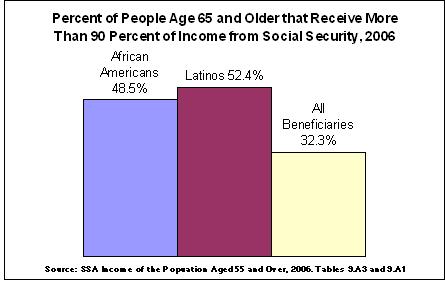(10 am. – promoted by ek hornbeck)
This is the third installment in our Social Security Works series. So far, we have seen how Social Security works for America, how Social Security works for women, and today we will show how Social Security works for people of color.
Social Security is neutral with respect to race and ethnicity; the benefits it pays are a function of a worker’s earnings history and family situation.
People of color face numerous structural inequities throughout their lives that Social Security, because of its progressive benefit structure, helps to alleviate.
Communities of color receive higher average returns on what they have paid into the system than do other workers. Latinos and African Americans also rely on Social Security for a greater share of their income in retirement.
• Nearly five million African Americans receive Social Security benefits; roughly half of them are retired workers, and the other half are either disabled workers or the spouses or children of disabled, retired, or deceased workers
• African Americans earn 73 percent as much as whites, on average, but because of Social Security’s progressive benefit structure, their average retirement benefit is about 85 percent as much as whites’
• Latinos also receive lower average wages than the rest of the population. Because of the progressive benefit formula, Latinos tend to receive more back from Social Security relative to the taxes they pay into the system than does the rest of the population
• Social Security is a particularly important source of income for elderly Latinos. In the absence of Social Security, more than half of elderly Latinos would live in poverty
• As of 2002, Social Security lifted 673,000 elderly Latinos out of poverty
• In 2003, Social Security reduced the poverty rate among Latinos aged 65 and over from 50 percent to 19.5 percent, a reduction of 31 percentage points
• In 2003, Social Security reduced the poverty rate among African Americans aged 65 and over from 56 percent to 23.7 percent, a reduction of 32 percentage points
Social Security also greatly benefits families of color:
• Some 800,000 African American Social Security beneficiaries are children under 18; almost 1 in every 19 African American children receives a monthly Social Security check.
• African Americans benefit disproportionately from Social Security’s disability and survivors benefits, since they are more likely than other workers to become disabled or die before retiring.
• African Americans constitute 11.5 percent of all workers who are covered by Social Security but 17.6 percent of Social Security disability beneficiaries.
• While 15 percent of all U.S. children are African American, 23 percent of the children receiving Social Security survivors benefits are.
• African Americans benefit from the fact that Social Security benefits are based on a worker’s highest 35 years of earnings. (Earnings in other years are disregarded.) Because African Americans have double the unemployment rates of whites and experience longer average spells of unemployment, they have more years with no earnings than whites do, on average. By not counting some years of little or no earnings in calculating benefits, Social Security benefits African Americans.
Social Security works for people of color; Social Security works.
Also posted at The Seminal and Daily Kos. This series is a project of Social Security Works.


